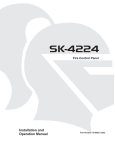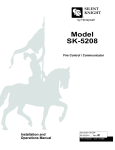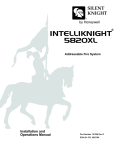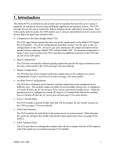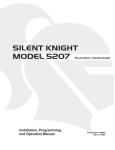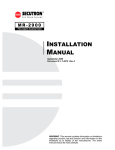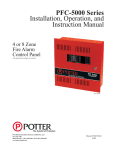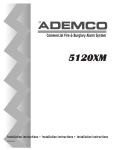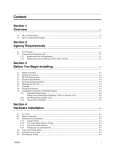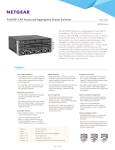Download SILENT KNIGHT 5104B Installation manual
Transcript
SILENT KNIGHT 5499 Distributed Power Module Installation Manual Part Number 151253F, 08/03 Content Section 1 Introduction .............................................................................................................................................. 1-1 Section 2 UL Requirements .............................................................................................................................. 1-2 Section 3 System Overview .............................................................................................................................. 1-3 3.1 3.2 3.3 Terminal Descriptions and Electrical Ratings ......................................................................................... 1-3 Signal Input Terminals ............................................................................................................................. 1-4 Notification Appliance Circuit Terminals ................................................................................................ 1-5 Section 4 Installation ................................................................................................................................................. 1-6 4.1 4.2 4.3 Mounting .................................................................................................................................................. 1-6 Wire Routing ............................................................................................................................................ 1-7 Current Requirements (Standby and Alarm) ........................................................................................... 1-8 4.3.1 Current Drawn From Host Panel ...................................................................................................... 1-8 4.3.2 Current Drawn from Battery ............................................................................................................. 1-8 4.4 Layout of the 5499 to a Control Panel ................................................................................................... 1-10 4.5 Trouble Relay ......................................................................................................................................... 1-11 4.6 Input and Output Wiring ........................................................................................................................ 1-11 4.6.1 Class A Supervised Wiring ............................................................................................................. 1-11 Class A Output Notification Appliance Circuits ......................................................................... 1-11 Class A Supervised Input Circuits .............................................................................................. 1-11 4.6.2 Class B Supervised Wiring ............................................................................................................. 1-12 Class B Output Notification Appliance Circuits ......................................................................... 1-12 Class B Supervised Input Circuits ............................................................................................... 1-13 4.7 Ground Fault Detection Enable/Disable Jumper ................................................................................... 1-13 4.8 AC Connection ....................................................................................................................................... 1-14 4.9 Battery Connection ................................................................................................................................ 1-14 4.10 DIP Switch Settings ............................................................................................................................... 1-15 4.10.1 Selecting the Standard Input/Output Configurations ...................................................................... 1-15 4.10.2 Selecting Synchronized Input/Output Configurations .................................................................... 1-17 4.10.2.1 Selecting Synchronized Faraday Configurations ................................................................. 1-17 4.10.2.2 Selecting Synchronized Gentex Configurations .................................................................. 1-17 4.10.2.3 Selecting Synchronized System Sensor Configurations ...................................................... 1-18 4.10.2.4 Selecting Synchronized Wheelock Configurations .............................................................. 1-18 4.10.2.5 Selecting Sychronized AMSECO Configurations ............................................................... 1-18 4.10.3 Setting the Loss of AC Delay ......................................................................................................... 1-19 4.10.4 Setting the Auxiliary Output ........................................................................................................... 1-19 P/N 151253 i Model 5499 Distributed Power Module Installation Manual Section 5 Connection to Silent Knight Panels Section 6 Sample Applications 6.1 6.2 6.3 .................................................................................................................. 1-24 Notification Power Applications ............................................................................................................ 1-24 Non-Resettable Power Application ........................................................................................................ 1-26 Door Holder Application ....................................................................................................................... 1-27 Section 7 Troubleshooting 7.1 7.2 7.3 .............................................................................................................................. 1-28 LEDs ...................................................................................................................................................... 1-28 Trouble Conditions ................................................................................................................................ 1-29 Removing and Replacing the Control Panel .......................................................................................... 1-30 7.3.1 Removing the Control Panel ........................................................................................................... 1-30 7.3.2 Replacing the Control Panel ........................................................................................................... 1-30 Appendix A UL Listed Notification Appliances A.1 ii ...................................................................... 1-20 ............................................................................ A-1 Notification Appliances .......................................................................................................................... A-1 P/N 151253 Section 1 Introduction The Model 5499 is a notification and auxiliary power expander that provides up to 9 amps of filtered, 24 volt power for powering notification appliances and auxiliary devices. The 5499 provides its own AC power connection, battery charging circuit, and battery connections. Used with security and fire panels, the 5499 enables you to connect and distribute power to many more devices than your panel may normally allow. • Input Configurations The 5499 has two optically isolated signaling inputs that provide the signal connection from the main control panel to the 5499 (see Section 3.2 for more details). • Output Configurations The 5499 has four power-limited notification appliance circuits that can be configured in various combinations of Class A and Class B circuits (see Section 3.3 for more details). • Auxiliary Power Configurations The 5499 has a dedicated, power-limited, auxiliary output that can be configured in two different ways. The auxiliary output can either be non-resettable (always on), or configured to switch off when the AC power goes off to conserve the battery standby power. When the auxiliary power is configured to switch off, there is a 30 second delay before the auxiliary power is turned off after the AC power goes off (see Section 4.10.4 for more details). • Form C Trouble Relay The 5499 includes a general trouble relay that will de-energize for any trouble situation on the 5499 (see Section 4.5 for more details). • Earth Fault Detection The 5499 monitors for earth faults to the system power or system ground. When detected, the system de-energizes the trouble relay and the input supervision relays (see Section 6.2 for details). • ANSI Temporal Code The 5499 provides two configuration options that will drive outputs with the ANSI temporal code if the inputs are on constant (see Section 4.10.1 for details). • Supports Synchronization appliances The 5499 provides configuration options that will eliminate the need for sychronization modules when using AMSECO, Faraday, Gentex, System Sensor or Wheelock sync appliances. P/N 151253 1 Model 5499 Distributed Power Module Installation Manual Section 2 UL Requirements When installed in accordance with NFPA 72 standards, the 5499 can be connected to UL Listed devices suitable for local service. The 5499 is also listed to meet UL standard 864 and power limiting requirements. The 5499 is compatible with any UL listed fire alarm control panel utilizing reverse polarity supervised notification appliance circuits, using 24 VDC regulated outputs. 2 P/N 151253 System Overview Section 3 System Overview CAUTION Each output circuit is rated at 3 amps. DO NOT OVERLOAD. Overloading a circuit will cause it to shut down (power limit). The circuit will automatically reset once you remove the overload condition. 3.1 Terminal Descriptions and Electrical Ratings Terminal # Description Ratings TB1 1 AC (black–“hot”) 2 Earth Ground 3 AC (white–“neutral”) 1 Auxiliary Power (-) 2 Auxiliary Power (+) 3 Notification 4 Output (-) 4 Notification 4 Output (+) 5 Notification 3 Output (-) 6 Notification 3 Output (+) 7 Notification 2 Output (-) 8 Notification 2 Output (+) 9 Notification 1 Output (-) 10 Notification 1 Output (+) 11 Normally Closed contact 12 Common 13 Normally Open contact 14 Input 2 15 Input 2 (-) 16 Input 2 (+) 17 Input 1 18 Input 1 (-) 19 Input 1 (+) 120 VAC 60 Hz, 3 A TB2 P/N 151253 24 VDC 3.0 amps 24 VDC 3.0 amps 24 VDC 3.0 amps 24 VDC 3.0 amps 24 VDC 3.0 amps Even though each output is rated for 3 amps, the total current draw from the 4 outputs and the auxiliary power must not exceed 9 amps of notification power. 2.5 A @ 30 VDC 9 - 30 VDC 9 - 30 VDC 3 Model 5499 Distributed Power Module Installation Manual 3.2 Signal Input Terminals Terminals 14 through 19 are polarized signal input terminals. They provide the signaling connection from the main panel to the 5499. See Figure 4-2 for more details. Section 5 shows connections to specific Silent Knight fire alarm control units. The main panel supervises its notification appliance circuits used for communicating with the 5499 the same way it supervises ordinary notification appliance circuits. The signal inputs on the 5499 monitor the polarity of the voltage coming from the main panel’s notification appliance circuits to determine when to operate the notification appliance circuits on the 5499. The 5499 emulates the trouble behavior of a normal notification appliance circuits by breaking the EOL supervision current for internal or output trouble conditions on the 5499. Note that the 5499 will accurately sense the polarity of the main panel’s notification appliance circuits to drive the outputs whether or not the supervision connection is intact. The following situations will disconnect the EOL supervision at the signal inputs and indicate a trouble condition: • Low AC power • Low Battery condition • Earth ground fault to the system power or system ground • Auxiliary output power-limited condition • EOL supervision trouble or power-limited condition at an output Trouble conditions will not necessarily occur for both inputs when the trouble is specific to a particular output. Only the signal input controlling the output circuit that is in trouble will indicate a trouble condition. Below are examples where both inputs do NOT indicate trouble for a trouble occurring at only one output circuit. Example 1: Example 2: If input 1 controls all four outputs, a fault on any output will cause input 1 to indicate trouble. The fault does not affect input 2. If input 1 controls outputs 1 and 2, and input 2 controls outputs 3 and 4, a fault condition on output 3 or 4 will cause input 2 to indicate trouble. The fault does not affect input 1. Note: Once the inputs are driven with forward polarity to activate the outputs, the main control panel will not be able to sense trouble conditions through its notification appliance circuits connected to the 5499 input circuits. Use the 5499 trouble relay when it is necessary to monitor trouble conditions and active alarm conditions at the same time. Section 7 explains the significance of each trouble condition in more detail. 4 P/N 151253 System Overview 3.3 Notification Appliance Circuit Terminals Terminals 3 through 10 are the NAC terminals. Each of the four outputs is rated at 3 amps, though you can only draw a total of 9 amps from the 5499. The 5499 outputs are short-circuit protected (power limited) according to UL 864 standards. Overcurrent indicators are yellow LEDs. The output voltage can vary depending on the load and input voltage. The four power-limited notification outputs can be configured as follows: • • • • Four Class B circuits Two Class A circuits One Class A and two Class B circuits Class B, ANSI temporal-coded circuits • • • • • Faraday synchronized outputs Gentex synchronized outputs System Sensor synchronized outputs Wheelock synchronized outputs AMSECO synchronized outputs One or both 5499 signal inputs control the NACs, depending on the specific configuration setup. Possible configurations for the 5499 are: For Option: 1 2 3 4 5 6 7 8 9 10 11 12 13 These Inputs: Input 1 Input 1 or Input 2 Input 1 Control These Outputs: All outputs Outputs 1, 2, 3, and 4 Outputs 1 and 2 As: Class B circuits Class B ANSI temporalcoded circuits Class B circuits Input 2 Outputs 3 and 4 Class B circuits Input 1 Output 1 Class B circuits Input 2 Outputs 2, 3, and 4 Class B circuits Input 1 Outputs 1-2 and 3-4 Class A circuit pairs Input 1 Outputs 1 and 2 Class B ANSI temporal-coded circuits Input 2 Outputs 3 and 4 Class B circuits Input 1 Outputs 1-2 Class A circuit pair Input 2 Outputs 3-4 Class A circuit pair Input 1 Outputs 1-2 Class A circuit pair Input 2 Outputs 3 and 4 Class B circuits Input 1 (Strobe Control) Input 2 (Audio Control) Input 1 (Strobe Control) Input 2 (Audio Control) Input 1 (Strobe Control) Input 2 (Audio Control) Input 1 (Strobe Control) Input 2 (Audio Control) Input 1 (Strobe Control) Input 2 (Audio Control) All outputs All outputs All outputs All outputs All outputs Class A or Class B Faraday Sync. Output Class A or Class B Gentex Sync. Output Class A or Class B System Sensor Sync. Output Class A or Class B Wheelock Sync. Output Class A or Class B AMSECO Sync. Output You can select which input controls which output, and which inputs are Class A and Class B using the 7-position DIP switch on the printed circuit board. See Section 4.10 for DIP switch settings. P/N 151253 5 Model 5499 Distributed Power Module Installation Manual Section 4 Installation Before installing the 5499, the AC input must first be wired into the building’s main electrical power through the TB1 terminals (see Figure 4-2). Shut off the electrical power to the 5499, and then complete the general installation of the 5499 using the information in this section. 4.1 Mounting Mount the 5499 in locations that meet the following temperature and humidity requirements. Do not expose the 5499 panel to conditions outside of these ranges. Temperature 0o C-49o C (32o F-120o F) Humidity 10%-85% at 30o C (86o F) noncondensing When mounting on interior walls, use appropriate screw anchors in plaster. When mounting on concrete, especially when moisture is expected, first attach a piece of 3/4-inch plywood to the concrete surface. Attach the 5499 to the plywood. 6 P/N 151253 Installation 4.2 Wire Routing To avoid induced noise (transfer of electrical energy from one wire to another), keep input wiring isolated from high current output and power-limited wiring. Induced noise can interfere with telephone communication or even cause false alarms. Avoid pulling one multiconductor cable for the entire system. Instead, separate high current input/output from low current. Separate power-limited from non-power-limited wiring. Non-power-limited wiring must be enclosed in conduit. Wiring within the cabinet should be routed around the perimeter of the cabinet. It should not cross the printed circuit board where it could induce noise into the sensitive microelectronics or pick up unwanted RF noise from the switching power supply circuit. Figure 4-1 Sample Wire Routing P/N 151253 7 Model 5499 Distributed Power Module Installation Manual 4.3 Current Requirements (Standby and Alarm) 4.3.1 Current Drawn From Host Panel Table 4-1 shows the 5499 current draw requirements from the main control panel when the panel’s notification appliance circuits is in alarm. The current draw from the main panel when it is supervising the 5499 is the same current draw that would be present when the main panel supervises an ordinary notification appliance circuits. Table 4-1: Alarm Current Drawn From Main Control Panel Panel Voltage Alarm Current (for typical voltages) drawn from main panel’s notification appliance circuits. 4.3.2 Current 12 VDC 6.5 mA 24 VDC One input circuit: 15 mA Both input circuits: 30 mA Current Drawn from Battery Batteries used with the 5499 must not exceed 33 AH, such as the Silent Knight Model 6712. Batteries larger then 7 AH will not fit into the 5499 cabinet and must be housed in the AB-33 Accessory Battery Cabinet. See Section 4.9 for battery installation. The following is the maximum current draw from the auxiliary power terminals for standby calculations. These currents assume 24 or 60 hours of standby time, followed by 5 minutes of maximum alarm current. • 195 mA for 24 Hour Standby • 39 mA for 60 Hour Standby The above numbers were calculated assuming the use of 7 AH batteries at 100% of rated capacity. The total current of the 5499, plus all items attached to it, must not exceed 9 A when the panel is in alarm. Use Table 4-2 to ensure that the current does not exceed 9 A and, that the desired amount of standby is possible for the battery intended to be used with the 5499. 8 P/N 151253 Installation Table 4-2: Battery Calculation Worksheet Number of Devices Device For each device use this formula: 5499 Distributed Power Module (Current draw from battery) This column 1 Standby Current Current per Device X This column Standby: = Current per number of devices. 75 mA Alarm: 75 mA 175 mA 5499 Current A Auxiliary Devices Alarm Current 175 mA 75 mA 175 mA Refer to device manual for current ratings. Alarm/Standby mA mA mA Alarm/Standby mA mA mA Alarm/Standby mA mA mA Alarm/Standby mA mA mA Auxiliary Devices Current mA mA B Notification appliances Refer to device manual for current ratings. Alarm: mA 0 mA mA Alarm: mA 0 mA mA Alarm: mA 0 mA mA Alarm: mA 0 mA mA Notification Appliances Current 0 mA mA mA mA E Total current ratings converted to amperes (line D x .001): A A F Number of standby hours (24 or 60 for NFPA 72, Chapter 1, 1-5.2.5). H C D Total current ratings of all devices in system (line A + line B + line C) G Multiply lines E and F. Total standby AH AH Alarm sounding period in hours. H (For example, 5 minutes = .0833 hours.) I Multiply lines E and H. J Add lines G and I. H AH Total alarm AH Total standby and alarm AH AH Total ampere-hours required AH Multiply line J by 1.20. K (20% extra insurance to meet desired performance) P/N 151253 9 Model 5499 Distributed Power Module Installation Manual 4.4 Layout of the 5499 to a Control Panel Figure 4-2 shows the general layout of the 5499 PC board. This section also provides specific wiring details for accessories. AC Connection Terminals See Section 7 for LED Description For UL listed Notification Appliances For connection to control panel Figure 4-2 The Model 5499 PC Board Layout Consult your installation manual for specific wiring information on the control panel being used. If you are using an Silent Knight control panel, see Section 5 for connections. 10 P/N 151253 Installation 4.5 Trouble Relay The 5499 has a Form C trouble relay built into Terminals 11-13. The relay provides a normally open and a normally closed contact, both of which are rated at 2.5A. The trouble relay will deactivate under any trouble condition. A typical application of the trouble relay is to connect the 5499 normally closed (N.C.) contacts in series with the EOL supplied with the fire alarm control panel. This will cause a trouble on the fire panel when the 5499 opens its trouble contacts. Note: The N.C. contact is the relay contact that is closed when the 5499 has power and there are no trouble conditions. Must be connected to a power limited source Figure 4-3 Trouble Relay Connection Example 4.6 4.6.1 Input and Output Wiring Class A Supervised Wiring Figure 4-4 shows how to wire for Class A input and output supervision. Use in/out wiring methods for proper supervision. (Refer to the Appendix for notification appliances compatible with the 5499.) Class A Output Notification Appliance Circuits The configuration shown in Figure 4-4 shows two, 3-amp devices wired as Class A circuits. When you are using the outputs as Class A circuits, loop the wiring back to the corresponding circuit pair. For Class A wiring, no external EOL is necessary since it is built into the 5499 board. Class A Supervised Input Circuits The configuration shown in Figure 4-4 shows Class A supervised wiring from a fire alarm control panel to the 5499 board. Pay close attention to the polarities when wiring a panel to the 5499 and follow these requirements: P/N 151253 11 Model 5499 Distributed Power Module Installation Manual • When wiring to terminal 18 on the 5499, you must use two separate wires. Do not loop a single wire or twist two conductors together. • Do not use notification appliances on Class A circuits connected to a 5499 for input. The 5499 will detect voltage across the input circuits, but is not designed to pass the added current load from notification appliances. Figure 4-4 Class A Supervised Input/Output Connections 4.6.2 Class B Supervised Wiring Figure 4-5 shows how to wire for Class B input and output supervision. Use in/out wiring methods for proper supervision (Refer to the Appendix for notification appliances that must be used with the 5499.) Class B Output Notification Appliance Circuits Figure 4-5 shows four, 1.5 amp devices wired as Class B circuits. Place a 4.7k ohm EOL resistor (provided) at the end of each circuit to enable supervision when using all outputs as Class B notification appliance circuits. The 4.7k EOLs must be wired to the terminals whether or not you are using all output terminals. 12 P/N 151253 Installation Class B Supervised Input Circuits Figure 4-5 shows Class B supervised wiring from a fire alarm control panel to the Model 5499. Use an EOL resistor as shown to enable notification input supervision. Some panels use EOLs that have a different value than the 4.7k ohm EOL resistor used by the 5499. In this case, the EOL must be UL listed for the fire alarm control panel (not the 5499). Figure 4-5 Class B Supervised Input/Output Connections 4.7 Ground Fault Detection Enable/Disable Jumper In some cases the ground fault detection feature on the 5499 may interfere with the ground fault detection feature of the main control panel in the system. To disable the ground fault detection feature on the 5499, place the jumper block on J1, across pins 1 and 2 (see Figure 4-2). P/N 151253 13 Model 5499 Distributed Power Module Installation Manual 4.8 AC Connection Wire AC power as shown in Figure 4-6. Figure 4-6 120 VAC Connection 4.9 Battery Connection You must use two 12 volt batteries with the 5499. Use two 12 VDC, 7 AH gel cell batteries in series, such as the Silent Knight Model 6712 inside the 54995499 cabinet. Batteries larger than 7 AH must use the 33-AB Accessory Battery Cabinet. It is recommended that you replace the batteries every five years. The following steps and diagram explain how to connect the batteries. 1. Connect the black wire from Battery – terminal to the negative (-) side of battery #2. 2. Connect the jumper wire provided from the positive (+) side of battery #2 to the negative side of battery #1. 3. Connect the red wire from Battery + terminal to the positive (+) side of battery #1. Jumper (P/N140694) Model 6712 (Supervised) Battery #1 Battery #2 Figure 4-7 Battery Connection 14 P/N 151253 Installation 4.10 DIP Switch Settings A 7-position DIP switch on the 5499 board allows you to select the following: • How long the 5499 will wait before indicating a loss of AC. • Which input (Input 1 or Input 2) will control the notification appliance circuits. • Which NACs to wire as Class A and Class B. • Auxiliary power state. • Which NACs to operate as steady outputs, ANSI temporal, or sync. outputs Refer to Figure 4-2 for the location of the DIP switch on the 5499 board. 4.10.1 Selecting the Standard Input/Output Configurations Figure 4-8 and Figure 4-9 show the position of each switch on the DIP for the non-synchronized input and output configurations. The position of Switch 4 and 5 do not affect the relationship of inputs to outputs. Note: The 5499 checks switches 1, 2, 3, and 6 only when powering up the 5499. If you change these switch settings, you must remove both the AC power and the battery to force the 5499 to recognize the new switch settings. Figure 4-8 Setting DIP Switches 1-3 P/N 151253 15 Model 5499 Distributed Power Module Installation Manual Figure 4-9 Setting DIP Switches 1-3 (Continued) Special Note for Input/Output Configurations That Select ANSI Temporal-Coded Outputs The DIP switch settings marked with an asterisk (*) in Figure 4-8 and Figure 4-9 are designed to produce ANSI temporal-coded outputs from a constant on input. The figures shown below compare the output patterns of configurations before and after the addition of this feature. Standard 5499 Input to Output Relationship Input/Output Relationship for ANSI Temporal-coded Options With this new feature, a steady signal can produce the pattern shown above for panels not previously able to do so. Note: The 5499 can also produce other temporal patterns if the patterns appear at the inputs for the non-ANSI temporal configurations. 16 P/N 151253 Installation 4.10.2 Selecting Synchronized Input/Output Configurations The following sections describe how to configure the 5499 as a synchronization power expander for AMSECO, Faraday, Gentex, or System Sensor or Wheelock synchronized horn/ strobe appliances. Note: In order for the synchronization feature to operate properly, make sure you have set the DIP switches for the proper manufacturer. See Sections 4.10.2.1, 4.10.2.2, or 4.10.2.3. Important! For all synchronization options, input 1 is the strobe input and input 2 is the audible input. The signals to input 1 and input 2 must be DC signals for the synchronization patterns to work properly. When it is desired to activate both strobes and audibles, input 1 and input 2 must be active. If it is desired to only activate strobes, then input 1 must be active and input 2 must be inactive. The audible can be deactivated and reactivated at any time by changing the signal at input 2 as long as input 1 remains active. If input 1 is not active, then input 2 is ignored. 4.10.2.1 Selecting Synchronized Faraday Configurations To select the input/outputs for Faraday synchronized appliances set the DIP switches as shown in Figure 4-10. Figure 4-10 Faraday Synchronization Configurations 4.10.2.2 Selecting Synchronized Gentex Configurations To select the input/outputs for Gentex synchronized appliances set the DIP switches as shown in Figure 4-11. Figure 4-11 Gentex Synchronized Configurations P/N 151253 17 Model 5499 Distributed Power Module Installation Manual 4.10.2.3 Selecting Synchronized System Sensor Configurations To select the input/outputs for System Sensor synchronized appliances, set the DIP switches as shown in Figure 4-12. Figure 4-12 System Sensor Synchronization Configurations 4.10.2.4 Selecting Synchronized Wheelock Configurations To select the input/outputs for Wheelock synchronization appliances set the DIP switches as shown in Figure 4-13. Figure 4-13 Wheelock Synchronization Configurations 4.10.2.5 Selecting Sychronized AMSECO Configurations To select the input/outputs for AMSECO synchronizated appliances, set the DIP switches as shown in Figure 4-14. Figure 4-14 AMSECO Synchronizated Configurations 18 P/N 151253 Installation 4.10.3 Setting the Loss of AC Delay Normal selection for reporting loss of AC is 6 hours. The ON position is for test purposes only and the normal position for Switch 4 is OFF. For testing the Low AC reporting, you can temporarily turn Switch 4 ON without removing power. Note: Remember to turn the switch OFF when testing is complete. Figure 4-15 Setting DIP Switch 4 4.10.4 Setting the Auxiliary Output Switch 5 on the DIP switch determines how the auxiliary power operates on the 5499. The 5499 checks switch 5 only when powering up the 5499. If you change this switch, you must remove both the AC power and the battery to force the 5499 to recognize the new switch setting. Figure 4-16 Setting DIP Switch 5 P/N 151253 19 Model 5499 Distributed Power Module Installation Manual Section 5 Connection to Silent Knight Panels The drawings in this section show you how to connect the 5499 to compatible Silent Knight panels. See panel installation manuals for more information. Figure 5-1 Connection to 5104 Fire Communicator Figure 5-2 Connection to 5104B Fire Communicator 20 P/N 151253 Connection to Silent Knight Panels Figure 5-3 Connection to 5204 Fire Control/Communicator Figure 5-4 Connection to 5207 Fire Control/Communicator P/N 151253 21 Model 5499 Distributed Power Module Installation Manual Figure 5-5 Connection to the SK-2224 Fire Alarm Control Panel Figure 5-6 Connection to the SK-4224 Fire Alarm Control Panel 22 P/N 151253 Connection to Silent Knight Panels Figure 5-7 Connection to the SK-6324 Fire Alarm Control Panel P/N 151253 23 Model 5499 Distributed Power Module Installation Manual Section 6 Sample Applications The drawings in this section show various 5499 configurations, including daisy-chaining. 6.1 Notification Power Applications 5499 Figure 6-1 Input 1 Activates All Four Outputs 5499 Figure 6-2 Input 1 Activates Outputs 1 and 2; Input 2 Activates Outputs 3 and 4 24 P/N 151253 Sample Applications Note: When multiple power supplies are used with one control unit they will not sync with each other. 5499 5499 Figure 6-3 One Control Activating Two 5499s 5499 5499 5499 Figure 6-4 One Control Activating Three 5499s in Series P/N 151253 25 Model 5499 Distributed Power Module Installation Manual 5499 5499 5499 Figure 6-5 Each Control Activates Five Notification Appliance Circuits 6.2 Non-Resettable Power Application The 5499 provides a dedicated 3-amp auxiliary power output that you can select as non-resettable (output is always on). See Section 4.10.4 for setting the auxiliary power. If you need more than 3 amps, wire the inputs as shown in Figure 6-6. Figure 6-6 Auxiliary Output Wiring for Non-Resettable Power 26 P/N 151253 Sample Applications 6.3 Door Holder Application In a typical door holder application, the door holder power must be interrupted to close all fire doors under the following conditions: • Any active alarm condition. • AC power is no longer present (to conserve battery power). To close the fire doors in these situations, wire an N.C. programmable relay from the fire panel in series with the auxiliary power to the door holders as shown in Figure 6-7. The circuit shown in Figure 6-7 will provide up to 3 amps of door holder power. (See Section 6.2 if you need more than 3 amps of auxiliary power.) The power in this example is released when AC power is off for 30 seconds or more, or when the relay from the fire panel becomes open. You would have to use the equivalent of a programmable relay from a fire alarm control panel that is programmed to transfer under alarm conditions. See Section 4.10.4 for selecting auxiliary power options. 5499 Fire Panel ESL DHX 1224 Figure 6-7 Door Holder Wiring Example P/N 151253 27 Model 5499 Distributed Power Module Installation Manual Section 7 Troubleshooting Light-emitting diodes (LEDs) indicate fault conditions. This section describes the LED states and provides trouble condition details. 7.1 LEDs The eight LEDs indicate a fault condition in one of the circuits (either NACs 1 through 4, auxiliary power, earth fault, low AC, or battery). A fault condition in the LED's corresponding circuit will light the LED (labeled on the board). Their functions are as follows: LED Color Description OUT1 Yellow When ON, output circuit 1 is in trouble or in an overcurrent state. OUT2 Yellow When ON, output circuit 2 is in trouble or in an overcurrent state. OUT3 Yellow When ON, output circuit 3 is in trouble or in an overcurrent state. OUT4 Yellow When ON, output circuit 4 is in trouble or in an overcurrent state. AUX Yellow When ON, the auxiliary power output is in an overcurrent state. FLT Yellow When ON, an earth ground fault on the unit exists. BATT Yellow When ON, a low battery condition exists. AC Green When OFF, there is no AC power to the unit. Under normal conditions, this LED is ON to indicate the presence of AC power. See Figure 4-2 for locations of LEDs. 28 P/N 151253 Troubleshooting 7.2 Trouble Conditions Trouble Condition What Happens Low AC Input 1 and Input 2 supervision circuits open after a 6 hour delay. (AC input voltage is low or off for 6 hours or longer.) The green AC LED turns off as soon as low AC or loss of AC occurs (does not wait 6 hours). The trouble relay is de-energized after a 6 hour delay. The trouble restores within 1 minute of the AC voltage restoring to a normal level. Low Battery Input 1 and Input 2 supervision circuits open. The yellow “BATT” LED lights. (Battery voltage is less than 21.4 VDC.) The trouble relay is de-energized. Earth Ground Fault Input 1 and Input 2 supervision circuits open. The yellow “FLT” LED lights. The trouble restores when battery voltage is greater than 22.4 VDC. (The earth terminal is connected The trouble relay is de-energized. to one of the positive or The trouble restores when the fault between the earth ground and one of the output circuit negative terminals on the output terminals is removed. or auxiliary output circuits.) Power Limit At AUX (Current draw at the auxiliary power terminals is exceeding 3.0 amps.) Power disconnects at the AUX terminal. Input 1 and Input 2 supervision circuits open. The yellow “AUX” LED lights. The trouble relay is de-energized. The trouble restores when the overcurrent condition no longer exists. When a circuit goes into a power limited state, it will reverse the polarity of the voltage at the terminals and verify the load. If it is more than 1k ohms, the power limit will self-restore. This does not automatically occur for some devices typically connected to auxiliary power. Power limit conditions do not restore in reverse polarity monitoring if the devices are not polarized (for example, some door holder devices). To allow automatic restores for power-limited auxiliary circuits, it is recommended that all non-polarized devices be polarized using a diode in series with each device. Power-limited OUTPUT (Current draw at an output terminal is exceeding 3.0 amps.) Power at the OUTPUT is disconnected. Input 1 and Input 2 supervision circuits open. The corresponding yellow LED lights. The trouble relay is de-energized. The trouble restores when the overcurrent condition no longer exists. EOL supervision trouble Input 1 and Input 2 supervision circuits open. Corresponding yellow LED lights. (Equivalent resistance of the EOL resistor is outside the range 2k - 10k.) The trouble relay is de-energized. Trouble restores if an EOL within (2k-10k) appears at the output terminals. Note: While Input 1 & 2 are activated, Input 1 & 2 will not open to indicate a trouble or supervisory condition. Once the circuit is deactivated it will open to indicate a trouble or supervisory condition. P/N 151253 29 Model 5499 Distributed Power Module Installation Manual 7.3 Removing and Replacing the Control Panel This section of the manual provides instruction on how to remove and replace the control panel if it is determined that the control panel needs to be repaired or replaced. 7.3.1 Removing the Control Panel Follow these step to properly remove the control panel: 1. Remove the two heat sink screws. The heat sink screws are located on the top of the cabinet. See Figure 7-1. Heat Sink Screws Chassis Mounting Screw Chassis Mounting Screw Figure 7-1 Mounting Screw Locations 2. Remove the four chassis mounting screws. See Figure 7-1 for chassis screw locations. 3. Carefully remove the control panel. 7.3.2 Replacing the Control Panel Follow these steps to replace the control panel: Note: Use a grounding strap when working with static sensitive components. 1. Align the control panel with the chassis mounting stand-offs. See Figure 7-1. 2. Insert the four chassis mounting screws (see Figure 7-1). Do not over tighten the chassis mounting screws. 3. Insert the two heat sink screws (see Figure 7-1). Do not over tighten the heat sink screws. 30 P/N 151253 Appendix A UL Listed Notification Appliances For proper operation, use polarized devices with a Model 7628 4.7k ohm EOL resistor on each circuit. All supervised notification appliances used with the 5499 must be polarized. Note: Not all devices can use the Sync feature, be sure to check Table A-1 to ensure the device you have chosen will work with this feature. A.1 Notification Appliances Table A-1 below lists notification appliances compatible with the 5499. Appliances which can be synchronized are indicated in the column marked Sync. Table A-1: Compatible Notification Appliances Manufacturer AMSECO Model Sync SH24W-153075 Horn/Strobe SL24W-153075 Strobe H24W P/N 151253 Horn 446 Vibrating Bell 476 Vibrating Bell 477 Single Stroke Bell 2700 -M. -R, -T, -Y, -Z Strobe 2701 Series Strobe 2705 Series Strobe 2820 Snyc Temporal Horn/Strobe 2821 Snyc Temporal Horn/Strobe 2824 Horn Strobe 5333 Faraday Type Multi-Tone Horn 5336 Multi-Tone Horn/Strobe 5337 Multi-Tone Horn/Strobe 5338 Multi-Tone Horn/Strobe 5343 Single Tone Horn/Strobe 5346 Electronic Horn with Strobe 5347 Electronic Horn with Strobe 5348 Single Tone Horn/Strobe 5373 8-Tone Horn/Strobe 5376 8-Tone Horn/Strobe 5377 8-Tone Horn/Strobe 5378 8-Tone Horn/Strobe 5383 8-Tone Horn/Strobe with Sync Strobe A-1 Model 5499 Distributed Power Module Installation Manual Table A-1: Compatible Notification Appliances Manufacturer Model Sync 5386 8-Tone Horn/Strobe with Sync Strobe 5387 8-Tone Horn/Strobe with Sync Strobe 5388 8-Tone Horn/Strobe with Sync Strobe 5405 Faraday (Cont.) Sync Control Unit 5508 Single Gang Sync Strobe 5509 Strobe 5510 Strobe 5511 Strobe 5512 Strobe 5516 Strobe 5517 Strobe 5518 Strobe 5519 Strobe 5521 4” Square Sync Strobe 5522 4” Square Sync Strobe 6120 Horn 6140 Horn 6223 Horn 6226 Horn/Strobe 6227 Horn/Strobe 6228 Horn/Strobe 6243 Electron-Mechanical Horn 6244 Electron-Mechanical Horn 6245 Electron-Mechanical Horn 6246 Electron-Mechanical Horn/Strobe 6247 Electron-Mechanical Horn/Strobe 6248 Electron-Mechanical Horn/Strobe 6300 A-2 Type Mini-Horn 6301 Mini-Horn 6302 Mini-Horn 6310 Mini-Horn/Strobe 6311 Mini-Horn/Strobe 6312 Mini-Horn/Strobe 6314 Series -M, -R, -T, -Y, -Z Strobe 6320 Sync Mini Horn/Strobe 6321 Sync Mini Horn/Strobe 6322 Mini Horn/Sync Strobe 6380 8-Tone Electronic Signal/Strobe P/N 151253 Table A-1: Compatible Notification Appliances Manufacturer FCI P/N 151253 Model Sync Type 130-3117C Mini Horn 130-3147C Mini Horn BLV-6 Vibrating Bell BLV-10 Vibrating Bell BLVCH Vibrating Chime H12/24-FC Horn H12/24W-FC Horn H12/24K-FC Horn HC12/24-FC Horn HC12/24W-FC Horn HC12/24K-FC Horn P2415-FC Horn/Strobe P2415W-FC Horn/Strobe P2415K-FC Horn/Strobe P241575-FC Horn/Strobe P241575W-FC Horn/Strobe P241575F-FC Horn/Strobe P241575K-FC Horn/Strobe P2430-FC Horn/Strobe P2430W-FC Horn/Strobe P2430K-FC Horn/Strobe P2475-FC Horn/Strobe P2475W-FC Horn/Strobe P2475K-FC Horn/Strobe P24110-FC Horn/Strobe P24110W-FC Horn/Strobe P24110K-FC Horn/Strobe S2415-FC Strobe S241575-FC Strobe S241575W-FC Strobe S241575K-FC Strobe S2430-FC Strobe S2430W-FC Strobe S2430K-FC Strobe S2475-FC Strobe S2475W-FC Strobe S2475K-FC Strobe S24110-FC Strobe S24110W-FC Strobe S24110K-FC Strobe MDL-FC Sync. Module MDLW-FC Sync. Module A-3 Model 5499 Distributed Power Module Installation Manual Table A-1: Compatible Notification Appliances Manufacturer Federal Signal Gentex Model Sync 450 Horn VALS Horn/Strobe GX90-4 Horn GXS-4-15-1 Strobe GXS-4-1575 Strobe GX90S-4-15 Horn GX90S-4-1575 Horn HG124 Horn SHG24-1575 Horn/Strobe SHG24-15 Horn/Strobe GEC Series Horn/Strobes GES Series Strobes GEH Horns GMH-24-X Horn GMS-24-X G0T24 ST/HS Commander Series Horn/Strobe Horn G0S24-X Horn Strobes & Horn/Strobes WGMS-24-X Horn/Strobe H12/24 Horn HC12/24 Horn MASS241 Horn/Strobe MASS24110ADA Horn/Strobe MASS2415ADA Horn/Strobe MASS2475ADA Horn/Strobe P2415 Horn/Strobe P241575 Horn/Strobe P2430 Horn/Strobe P2475 Horn/Strobe Horn/Strobe S2415 Strobe S241575 Strobe S2430 Strobe S24110 Strobe SS24110ADA Strobe SS2415ADA Strobe SS2475ADA Strobe PS2415ADA Mini-Horn/Strobe PS241575ADA Mini-Horn/Strobe PS24110ADA Mini-Horn/Strobe System Sensor P24110 A-4 Type P/N 151253 Table A-1: Compatible Notification Appliances Manufacturer Model System Sensor PS2475ADA (Cont.) MDL Wheelock P/N 151253 Sync Type Mini-Horn/Strobe Sync. Module MDLW Sync. Module 46T-G4-24-R Bell 46T-G6-24-R Bell 46T-G10-24-R Bell 46T-G6-24-WS-24-HF-R Strobe/Bell 46T-G10-24-WS-24-HF-R Strobe/Bell 46T-G6-24-WH-24-HF-R Strobe/Bell 46T-G10-24-WH-24-HF-R Strobe/Bell 7001T-12\24-W-FR Strobe Horn 7002T-12\24-W-FR Strobe Horn AES-DL1-R Multitone Horn AES-EL1-R Multitone Horn AES-DL1-WS-24-VF-R Multitone Horn AES-EL1-WS-24-VF-R Multitone Horn AES-DL1-WH-24-VF-R Multitone Horn AES-EL1-WH-24-VF-R Multitone Horn AES-DL1-WM-24-VF-R Multitone Horn AES-EL1-WM-24-VF-R Multitone Horn AH-24-R Horn AH-24WP-R Horn AMT-12\24-R Strobe Horn AMT-24-LS-VFR Strobe Horn AMT-24-LSM-VFR Strobe Horn AMT-24-IS-VFR Strobe Horn AS-24MCW-FR Strobe Horn AS-24MCW-FW Strobe Horn AS-2415W-FR Strobe Horn AS-2415C-FW Strobe Horn AS-241575W-FR Strobe Horn AS-2475C-FW Strobe Horn AS-24100C-FW Strobe Horn AS-2430W-FR Strobe Horn AS-2430C-FW Strobe Horn AS-2475W-FR Strobe Horn AS-24110W-FR Strobe Horn ASWP-2475W-FR Strobe Horn SM-12\24-R Strobe Horn Controller DSM-12\24-R Strobe Horn Controller CF-BF1 Chime A-5 Model 5499 Distributed Power Module Installation Manual Table A-1: Compatible Notification Appliances Manufacturer Wheelock (Cont.) A-6 Model Sync Type CF-BF1-R Chime CH-CF1 Chime CH-CF1-R Chime CH-CF1-W Chime CH-DF1 Chime CH-DF1-R Chime CH-BF1-WS-24-HF-R Strobe Chime CH-CF1-LS-24 Strobe Chime CH-CF1-MS-24 Strobe Chime CH-CF1-IS-24 Strobe Chime CH-CF1-LS-24-CFW Strobe Chime CH-CF1-MS-24-CFW Strobe Chime CH-CF1-IS-24-CFW Strobe Chime CH-CF1-WS-24-CF-W Strobe Chime CH-DF1-LS-24 Strobe Chime CH-DF1-MS-24 Strobe Chime CH-DF1-IS-24 Strobe Chime CH-DF1-LS-24-VFR Strobe Chime CH-DF1-LSM-24-VFR Strobe Chime CH-DF1-MS-24-VFR Strobe Chime CH-DF1-IS-24-VFR Strobe Chime CH-DF1-WM-24-VFR Strobe Chime CH-DF1-WS-24-VF-R Strobe Chime DSM-12/24 Sync Module EH-DL1-R Electronic Horn EH-EL1-R Electronic Horn Electronic Horn EHS-DL1-W-VF-R Strobe Horn (single input) EHS-EL1-W-VF-R Strobe Horn (single input) EH-DL1-WS-24-VF-R Strobe Horn (dual input) EH-EL1-WS-24-VF-R Strobe Horn (dual input) EH-DL1-WH-24-VF-R Strobe Horn (dual input) EH-EL1-WH-24-VF-R Strobe Horn (dual input) EH-DL1-WM-24-VF-R Strobe Horn (dual input) EH-EL1-WM-24-VF-R Strobe Horn (dual input) HSW-24-HFR Remote Strobe HS2W-24-HFR Remote Strobe HSPW-24-HFR Remote Strobe IS-24-VFR Remote Strobe P/N 151253 Table A-1: Compatible Notification Appliances Manufacturer Wheelock (Cont.) P/N 151253 Model Sync Type IS1-24-VFR Remote Strobe IS3-24-VFR Remote Strobe ISP-24-HFR Remote Strobe LS-24-VFR Remote Strobe LS1-24-VFR Remote Strobe LS3-24-VFR Remote Strobe LSP-24-HFR Remote Strobe LSM-24-VFR Remote Strobe LS1M-24-VFR Remote Strobe LS3M-24-VFR Remote Strobe LSPM-24-VFR Remote Strobe MS-24-VFR Remote Strobe MS1-24-VFR Remote Strobe MS3-24-VFR Remote Strobe MSP-24-HFR Remote Strobe MB-G6-24-R Motor Bell MB-G10-24-R Motor Bell MBS-G6-24-W-HF-R Motor Bell with Strobe MBS-G10-24-W-HF-R Motor Bell with Strobe MIZ-24-R Mini-Horn MIZ-24-W Mini-Horn MIZ-24-LS-VFR Mini-Horn/Strobe MIZ-24-LSM-VFR Mini-Horn/Strobe MIZ-24-MS-VFR Mini-Horn/Strobe MIZ-24-HSW-HFR Mini-Horn/Strobe MIZ-24-IS-VFR Mini-Horn/Strobe MIZ-24-WS-VF-R Mini-Horn/Strobe MIZ-24-WS-VF-W Mini-Horn/Strobe MIZ-24-WH-VF-W Mini-Horn/Strobe MIZ-24-WM-VF-W Mini-Horn/Strobe MT-12/24-R Strobe Horn MT-24-LS-VFR Strobe Horn MT-24-LSM-VFR Strobe Horn MT-24-MS-VFR Strobe Horn MT-24-IS-VFR Strobe Horn MT-24-SL-VFR Strobe Horn MT-24-SLM-VFR Synch. Multitone Strobe MT-24-WM Strobe MT-24-WM-VFR Horn A-7 Model 5499 Distributed Power Module Installation Manual Table A-1: Compatible Notification Appliances Manufacturer Wheelock (Cont.) A-8 Model Sync Type NS-24MCM-FR Horn Strobes NS-24MCW-FW Horn Strobes NS-2415W-FR Horn Strobes NS-241575W-FR Horn Strobes NS-2430W-FR Horn Strobes NS-2475W-FR Horn Strobes NS-24110W-FR Horn Strobes NS4-24MCW-FR Horn Strobes NS4-24MCW-FW Horn Strobes NS4-241575W-FR Horn Strobes NH-12/24-R Horn RS-2415-HFR Strobe RSP-2415-VFR Strobe RS-241575-VFR Strobe RSP-241575-VFR Strobe RS-2430-VFR Strobe RS-2430-HFR Strobe RS-2475-VFR Strobe RSP-2475-HFR Strobe RS-24110-HFR Strobe RSP-24110-HFR Strobe SL-24-VFR Synchronized Remote Strobe SL1-24-VFR Synchronized Remote Strobe SL3-24-VFR Synchronized Remote Strobe SLP-24-VFR Synchronized Remote Strobe SLM-24-VFR Synchronized Remote Strobe SL1M-24-VFR Synchronized Remote Strobe SL3M-24-VFR Synchronized Remote Strobe SLPM-24-VFR Synchronized Remote Strobe SHW-24-VFR Synchronized Remote Strobe SH2W-24-VFR Synchronized Remote Strobe SHPW-24-VFR Synchronized Remote Strobe SCM-24-R Controller for Synchronized Strobes P/N 151253 Table A-1: Compatible Notification Appliances Manufacturer Wheelock (Cont.) P/N 151253 Model Sync Type SM-12/24-R Sync Module SR-2415-VFR Sync Strobe SRP-2415-HFR Sync Strobe SR-241575-VFR Sync Strobe SRP-241575-VFR Sync Strobe SR-2475-VFR Sync Strobe SR-2475-HFR Sync Strobe SR-24110-HFR Sync Strobe SRP-24110-HFR Sync Strobe V7001T-12\24-W-FR Strobe Horn WM3T-24-FR Remote Strobe WM3T-24-VFR Remote Strobe WS1T-24-FR Strobe WS3T-24-FR Strobe WST-24-FR Strobe A-9 Model 5499 Distributed Power Module Installation Manual A-10 P/N 151253 Silent Knight Fire Product Warranty and Return Policy General Terms and Conditions • All new fire products manufactured by Silent Knight have a limited warranty period of 18 months from the date of manufacture against defects in materials and workmanship. See limited warranty statement for details. • This limited warranty does not apply to those products that are damaged due to misuse, abuse, negligence, exposer to adverse environmental conditions, or have been modified in any manner whatsoever. Repair and RA Procedure • All products that are returned to Silent Knight for credit or repair require a RA (Return Authorization) number. Call Silent Knight Customer Service at 800-446-6444 or 763-4936435 between 8:00 A.M. and 4:45 P.M. CST, Monday through Friday to obtain a return authorization number. Silent Knight Technical Support is available at 800-328-0103 between 8:00 A.M. and 6:00 P.M. CST, Monday through Friday. • RA number must be prominently displayed on the outside of the shipping box. See return address example under Advanced Replacement Policy. • Include a packing slip that has the RA number, a content list, and a detailed description of the problem should be included with each return. • All products returned to Silent Knight must be sent freight pre-paid. After product is processed, Silent Knight will pay for shipping product back to customer via UPS ground. • Return the Silent Knight product circuit board only. Products that are returned in cabinets will be charged an additional $50 to cover the extra shipping and handling costs over board only returns. Do not return batteries. Silent Knight has the authority to determine if a product is repairable. Products that are deemed un-repairable will be returned to the customer. • Product that is returned that has a board date code more than 18 months from date of manufacture will be repaired and the customer will be assessed the standard Silent Knight repair charge for that model. Advanced Replacement Policy • Silent Knight offers an option of advance replacement for fire product printed circuit boards that fail during the first 6 months of the warranty period. • For advance replacement of a defective board contact your local Silent Knight Distributor or call Silent Knight at 800-446-6444 or 763-493-6435 to obtain a RA (Return Authorization) number and request advanced replacement. • Customers without a Silent Knight account must use a MasterCard, Visa, or American Express credit card to get an advance replacement. • A new or refurbished board will be shipped to the customer. The customer will initially be billed for the replacement board but a credit will be issued after the repairable board is received at Silent Knight. All returned products must comply with the guidelines described under “General Terms and Conditions”. • The defective board must be returned within 30 days of shipment of replacement board for customer to receive credit. No credit will be issued if the returned board was damaged due to misuse or abuse. • Repairs and returns should be sent to: Silent Knight Attn: Repair Department 7550 Meridian Circle Suite 100 Maple Grove, MN 55369-4927 RA Number:___________________ Limited Warranty Silent Knight warrants that the products of its manufacture shall be free from defects in materials or workmanship for 18 months from the manufacturing date code on the printed circuit board, if such goods have been properly installed, are subject to normal proper use, and have not been modified in any manner whatsoever. Upon return of the defective product, Silent Knight will at its sole discretion, either repair or replace, at no cost, such goods as may be of defective material or workmanship. Customers outside the United States are to return products to their distributor for repair. Silent Knight SHALL NOT UNDER ANY CIRCUMSTANCES BE LIABLE FOR ANY INCIDENTAL OR CONSEQUENTIAL DAMAGES ARISING FROM LOSS OF PROPERTY OR OTHER DAMAGE OR LOSSES OWING TO THE FAILURE OF Silent Knight PRODUCTS BEYOND THE COST OF REPAIR OR REPLACEMENT OF ANY DEFECTIVE PRODUCTS. Silent Knight MAKES NO WARRANTY OF FITNESS OR MERCHANTABILITY AND NO OTHER WARRANTY, ORAL OR WRITTEN, EXPRESS OR IMPLIED, BEYOND THE 18 MONTH WARRANTY EXPRESSLY SPECIFIED HEREIN. 7550 Meridian Circle Maple Grove, MN 55369-4927 612-493-6455 1-800-328-0103 Fax: 612-493-6475 © 2003 Silent Knight Part Number 151253F, 08/03














































